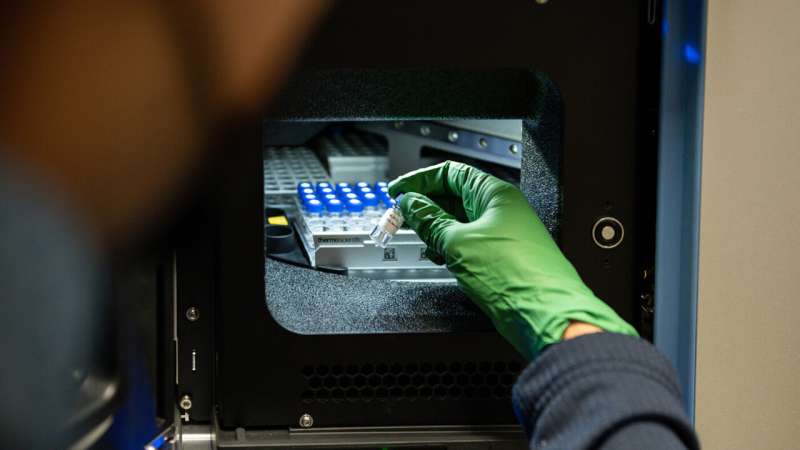This article has been reviewed according to Science X's editorial process and policies. Editors have highlighted the following attributes while ensuring the content's credibility:
fact-checked
peer-reviewed publication
trusted source
proofread
How high altitude changes your body's metabolism

Compared to those of us who live at sea level, the 2 million people worldwide who live above 4,500 meters (or 14,764 feet) of elevation—about the height of Mount Rainier, Mount Whitney, and many Colorado and Alaska peaks—have lower rates of metabolic diseases such as diabetes, coronary artery disease, hypercholesterolemia, and obesity.
Now, researchers at Gladstone Institutes have shed light on this phenomenon. They showed how chronically low oxygen levels, such as those experienced at high elevation, rewire how mice burn sugars and fats. The work, published in the journal Cell Metabolism, not only helps explain the metabolic differences of people who live at high altitude, but could also lead to new treatments for metabolic disease.
"When an organism is exposed to chronically low levels of oxygen, we found that different organs reshuffle their fuel sources and their energy-producing pathways in various ways," says Gladstone Assistant Investigator Isha Jain, Ph.D., senior author of the new study. "We hope these findings will help us identify metabolic switches that might be beneficial for metabolism even outside of low-oxygen environments."
Mimicking high altitude living
Around sea level, where a third of the world's population lives, oxygen makes up about 21 percent of the air we breathe. But people who live above 4,500 meters, where oxygen makes up just 11 percent of the air, can adapt to the shortage of oxygen—known as hypoxia—and thrive.
Researchers studying the impact of hypoxia have typically carried out their research in isolated cells or within cancerous tumors, which often lack oxygen. Jain's group wanted a more nuanced look at how long-term hypoxia impacts organs throughout the body.
"We wanted to profile the metabolic changes that take place as an organism adapts to hypoxia," says Ayush Midha, a graduate student in Jain's lab and first author of the new paper. "We thought this might provide some insight into how that adaptation protects against metabolic disease."
Midha, Jain, and their colleagues at Gladstone and UC San Francisco (UCSF) housed adult mice in pressure chambers containing either 21 percent, 11 percent, or 8 percent oxygen—all levels at which both humans and mice can survive. Over 3 weeks, they observed the animals' behavior, monitored their temperature, carbon dioxide levels and blood glucose, and used positron emission tomography (PET) scans to study how different organs were consuming nutrients.
Redistributing fuel
In the first days of hypoxia, the mice living in 11 percent or 8 percent oxygen moved less, spending hours completely still. By the end of the third week, however, their movement patterns had returned to normal. Similarly, carbon dioxide levels in the blood—which decrease when mice or humans breathe faster to try to get more oxygen—initially decreased but returned to normal levels by the end of the 3 weeks.
The animals' metabolism, however, seemed more permanently altered by the hypoxia. For animals housed within the hypoxic cages, blood glucose levels and body weight both dropped, and neither returned to pre-hypoxic levels. In general, these more lasting changes mirror what has been seen in humans who live at high altitude.
When the researchers analyzed PET scans of each organ, they also discovered lasting changes. To metabolize fatty acids (the building blocks of fats) and amino acids (the building blocks of proteins), the body needs high levels of oxygen, while less oxygen is required to metabolize the sugar glucose. In most organs, hypoxia led to an increase in glucose metabolism—an expected response to the shortage of oxygen. But the scientists found that in brown fat and skeletal muscle—two organs already known for their high levels of glucose metabolism—levels of glucose consumption instead went down.
"Prior to this study, the assumption in the field was that in hypoxic conditions, your whole body's metabolism becomes more efficient in using oxygen, which means it burns more glucose and fewer fatty acids and amino acids," says Jain, who is also an assistant professor in the Department of Biochemistry at UCSF. "We showed that while some organs are indeed consuming more glucose, others become glucose savers instead."
In retrospect, Jain says the observation makes sense; the isolated cells previously studied don't need to make trade-offs to save glucose, while an entire animal, to survive, does.
The lasting effects of long-term hypoxia seen in the mice— lower body weight and glucose levels—are both associated with a lower risk of diseases in humans, including cardiovascular disease. Understanding how hypoxia contributes to these changes could lead to new drugs that mimic these beneficial effects.
With that goal in mind, Jain's group hopes to follow up on this work with studies that look even more closely at how individual cell types and levels of signaling molecules change in different ways with hypoxia. Such research could point toward ways to mimic the protective metabolic effects of hypoxia with drugs—or high-altitude trips.
"We already see athletes going to train at altitude to improve their athletic performance; maybe in the future, we'll start recommending that people spend time at high altitude for other health reasons," says Midha.
More information: Ayush D. Midha, Organ-Specific Fuel Rewiring in Acute and Chronic Hypoxia Redistributes Glucose and Fatty Acid Metabolism, Cell Metabolism (2023). DOI: 10.1016/j.cmet.2023.02.007




















